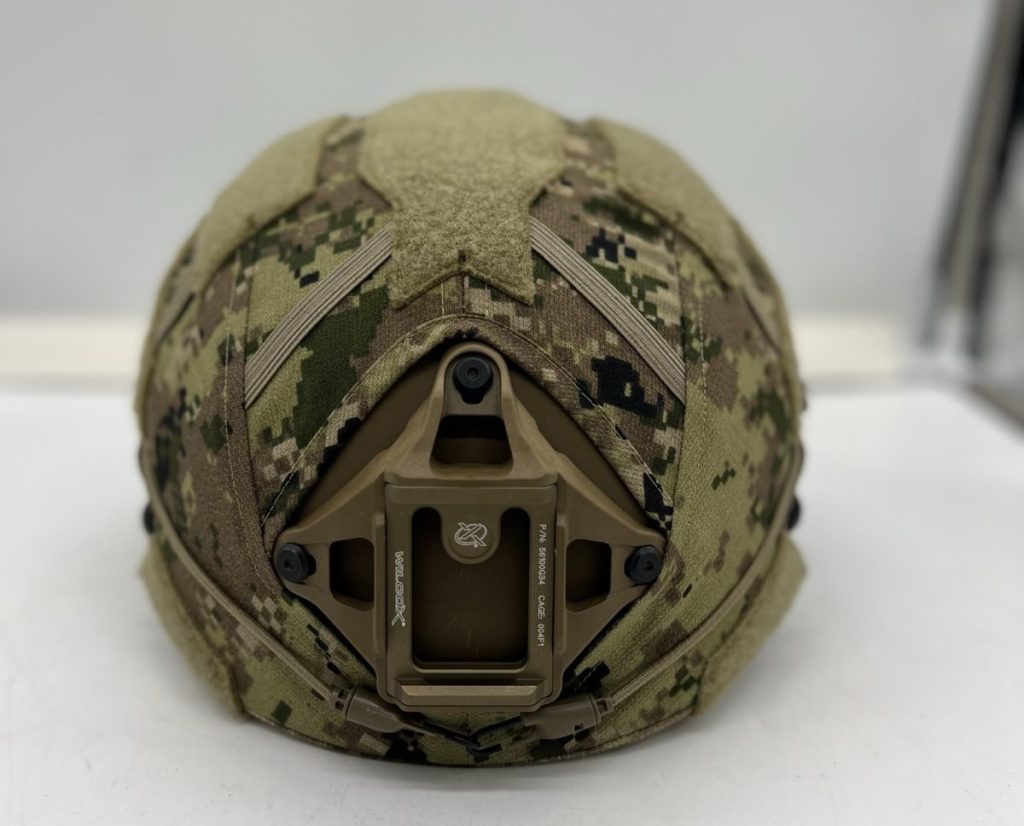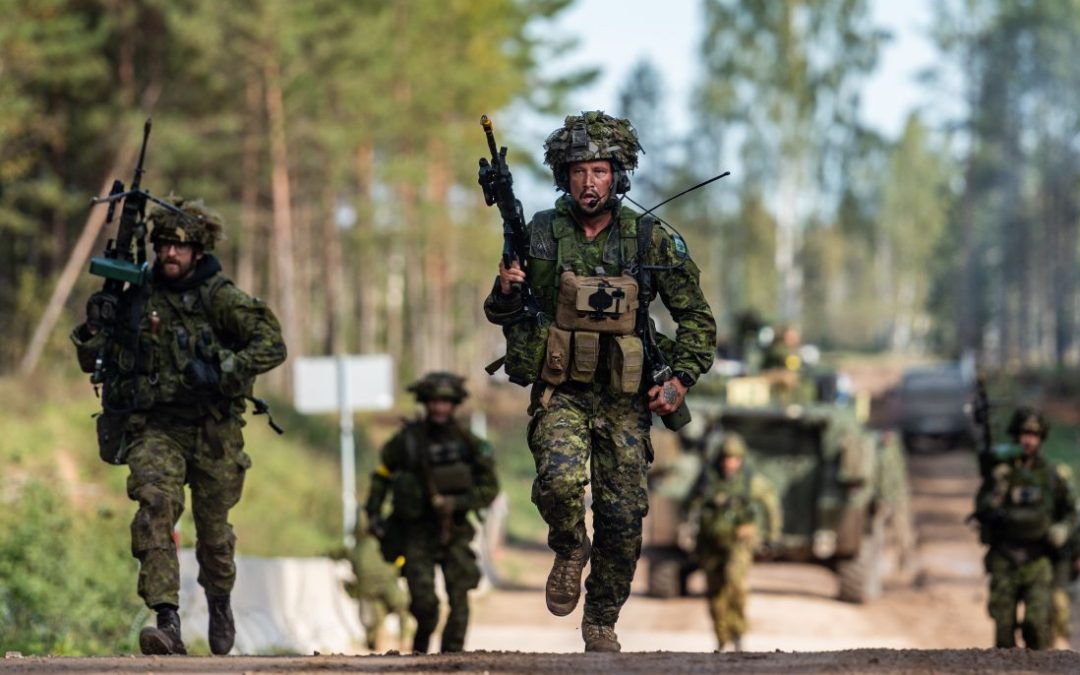by Canadian Army Today Staff
If you have noticed more requests for participation by your unit in equipment trials over the past few years, you are probably not alone.
From an integrated soldier information sharing system, to light off-road vehicles, camouflage patterns, clothing, helmets and other personal equipment, the Army is increasingly turning to soldier input before it finalizes statements of requirements or selects a winning bid.
“We want buy-in,” said Warrant Officer Duane Gyuricska, the deputy project director of an initiative called Dismounted Infantry Capability Enhancement (DICE) that has delivered a new helmet for the light infantry and is in the process of acquiring a load carriage modular fighting rig for those same units.
The equipment was originally part of an initiative called Soldier Operational Clothing and Equipment Modernization (SOCEM), which includes modernizing everything from footwear, all-weather gear, and gloves to ballistic helmets, rucksacks, and patrol packs.
Because of the nature of the equipment being acquired and the range of soldiers requiring it, DICE was hived off from SOCEM in 2020 to give the team at the Directorate of Land Requirements (DLR) and Assistant Deputy Minister, Materiel (ADM (Mat)) the ability to purchase smaller quantities for specific communities while trialing procurement methods that could inform the larger SOCEM initiative.
“DICE is an initiative, not a project,” noted Captain Jun Bae, the project director at DLR. “It looks to enhance and modernize any equipment for the dismounted infantry, primarily the light infantry battalions. But we are also trying to include any enablers and support units that are tasked to do specialized mission profiles.”
While DICE targets the light infantry, SOCEM will deliver the same type of equipment for the wider Army, but with some lessons learned from DICE, explained Andre-Marc Dallaire, the section head for personal and night vision equipment at ADM (Mat). “[DICE] gives us a jumping board toward SOCEM. We are testing some of the ways we’re doing things with DICE to incorporate those with SOCEM.”
By adopting a more focused approach for equipment like helmets and load carriage systems, the team has been able to conduct controlled trials and gather detailed data and individual soldier feedback on form, fit and performance.
“We expect light infantry to operate in any terrain, ranging from reconnaissance to pioneer and mortar tasks, and we need them to have modernized gear that allows them to do that,” said Bae.
Last November, the DICE team travelled to Edmonton to work with members of the 3rd Battalion, Princess Patricia’s Canadian Light Infantry (3 PPCLI) on a series of trials to test three helmet options under operational-like conditions, such as moving, shooting, and communicating. The experiments included small arms weapons firing from various positions, and how well the helmets worked with current night vision goggles, gas masks, hearing protection, communication systems, winter gear and the balaclava.
All three options performed well, but members of 3 PPCLI gave the Galvion Caiman the highest rating by a significant margin. “We want the troops to want to wear it,” said Gyuricska.
The Army has since signed an implementation order and ADM (Mat) expects to provide the new helmets to the light infantry battalions this fall. Other units will be asked to provide feedback on how well the Caiman works in their roles in the coming year.
Although the fit of a helmet might seem a subjective matter, the user trials were conducted in a controlled manner. “There was a very structured and scientific method to this evaluation, with a good sample size, to give us reliable information,” said Dallaire.
“It was very much a hands-on evaluation,” added Alex Legault, a personal protective equipment technologist with ADM (Mat). “People will tell us if the gear doesn’t fit them, but in a bid evaluation we have to take that personal element and make it as objective as possible.”
There is back-and-forth with industry to ensure equipment meets the Army’s requirements, but also that industry input can inform the specifications, Legault noted. The three helmet options were acquired through a phased bid compliance process, with an initial contract for a small quantity.
Soldiers can be brutally honest in their assessment of new kit, Gyuricska acknowledged, and their professional judgment is an important part of the process.
“We really want to push the idea that as professional soldiers, their opinion should matter for the procurement system we are trying to build,” said Bae.
Ultimately, the Army needs soldiers to want to wear their gear, said Gyuricska. As a warrant officer, he has never had to tell troops to wear their Oakley glasses. Quite the opposite. Soldiers like the professional look and, in certain circumstances, he must ask them to take off the glasses. Likewise with a new helmet, the aim is to provide gear that soldiers will see as professional and want to wear because it is comfortable and functional.
“This was one of the first trials done in this manner,” he said, “and we are trying to shift the process to do this more often. It’s become the gold standard. We really want to hear what the end user thinks. We can give them a helmet, but if they don’t want to wear it, it’s just another fight [to make that happen.]”

Carrying the load
The DICE team focus is now on a load carriage system for the dismounted light infantry that would include ballistic plates, fragmentation armour, vests, pouches and packs. A broad user trial with several options could begin between summer and fall 2024, and the team hopes to have a decision and new kit within the next 18 months.
“We are purchasing them as a set so that we don’t run into compatibility problems buying one piece at a time with this type of gear,” said Legault. Industry will be invited to provide their best solutions for a down-select for the user trials, rather than conform to a detailed list of prescriptive specifications, he added.
From the initial testing with the light infantry and support units, the SOCEM program will then assess how well the load carriage system works for other units across the Army. The Army wants a set of equipment that is lightweight and functional, Gyuricska said, but also modular and easily customizable.
“We are looking at reducing burden. Not just physical burden but mental burden as well,” he said. “We want to make sure that the kit we give soldiers is going to be easy to use. Maybe I don’t want a certain pouch on my left side. Maybe I like my vest a little higher on my waist. [Troops] want that sort of adaptability.”
Some accessories such as a medical kit will need to be in the same easily identifiable pouch and on the same side of every soldier, but some jobs may require different kit or more ammunition, and soldiers may perform multiple tasks in a unit.
“You may have several jobs and you may need to modify your kit to do that,” Gyuricska said. “Uniformity is not the answer to that solution. We need specific pouches to hold specific things, but sometimes where that goes might not be as important as it once was. We want to give soldiers the ability to expand the number of pouches if needed, especially on operations.”
As part of the DICE initiative, the team is paying particular attention to sizing and armour plating that can be adapted to fit all sizes and shapes. But the solution it selects for the light infantry won’t necessarily be the final word, said Bae.
“For SOCEM, we have the ability to change and write different requirements if we realize that the DICE [solution] is not working for some set of people.”


If the light infantry have their kit upgraded , is the mechanized infantry will have the same upgrade to ? They are subjected to do the same task as light infantry and also a lighter helmet would be good against whiplash in the LAV 6 and the high cut feature will be also much appreciated by the guys using coms inside and outside the vehicle.
May be this follow-on order is large enough to kit out the mech inf:
https://canadianarmytoday.com/galvion-receives-follow-on-batlskin-caiman-helmet-order-for-canadian-dice-program/